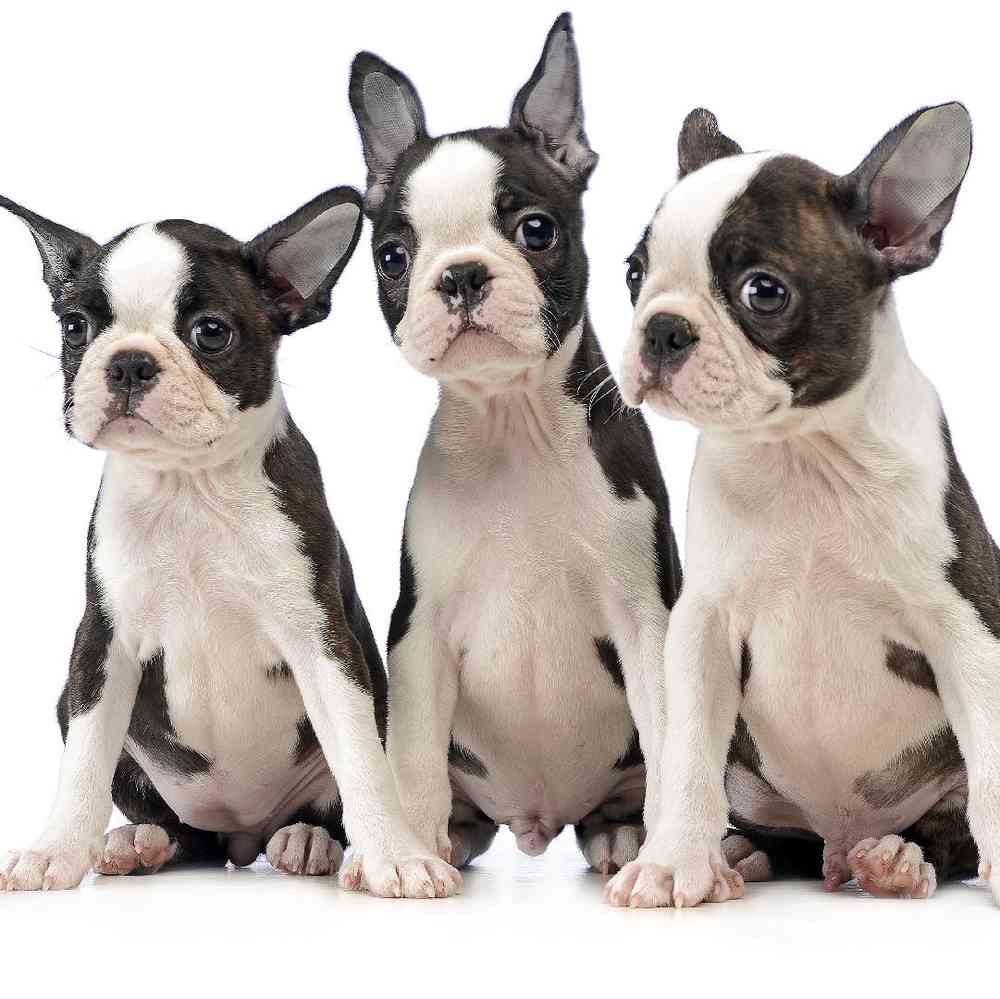
Guard Dog
Apartment Friendly
AKC Registrable
Family Dog
Boston Terrier
The Boston Terrier is a lively little companion recognized by his tight tuxedo jacket, sporty but compact body, and the friendly glow in his big, round eyes. His impeccable manners have earned him the nickname “The American Gentleman.”
Available Pups
All our Pets have found their homes. Please enter your contact information below so we can get in touch with you when we have found the perfect Pets for your family.
Puppy Knowledge
Breed Info
Clubs, Registries & Associations
American Canine Association Continental Kennel Club Universal Kennel Club International American Kennel Club United All Breed Registry America's Pet Registry, Inc. United Kennel Club (Based on breed recognition. See store for details on this particular puppy.)
Group
Non-Sporting
Heritage
Today’s Boston Terrier is a descendant of several 19th century breeds: the English Bulldog, English Terrier and French Bulldog. The name, Boston Terrier, comes from the name of the town where today’s breed originated: Boston.
Description
Small, 15” at the shoulders, 10- 25 pounds. The Boston Terrier has a compact and muscular body. Their short coat comes in black and white, brown and white, brindle and white, and seal. They do have a brachycephalic muzzle and are sensitive to weather extremes.
Health Awareness
The Boston Terrier has a life expectancy of 15 years and is prone to breathing difficulties due to the brachycephalic muzzle; hot or cold weather extremes are dangerous for their breathing. Also prone to deafness, hypothyroidism, luxating patellas, heart disease, skin tumors. and eye problems such a cataracts, entropion, glaucoma, cherry eye, dry eye, corneal ulcers and injury.
Personality
The Boston Terrier is alert, high-spirited, enthusiastic, feisty, but well-mannered and friendly with people. They are highly intelligent, eager to learn and easy to train with your patience, however, they are also highly independent thinkers. They require calm, confident and consistent leadership using only humane and motivational techniques.
Exercise/Energy Level
An energetic breed but are easily exercised with a long daily walk and/or off leash play in a safe area. Be sure to give your Boston Terrier plenty of mental stimulation, though, or this breed can become destructive when bored. Get your vet’s permission to exercise in extreme hot or cold weather.
Additional Information
Grooming Requirements: Regular brushing and an occasional bath. Coat: Short and smooth Shedding: Average shedding Hypoallergenic: No Apartment Living: Usually okay for apartment, but this breed can be prone to watchdog barking. They are usually inactive indoors, but do need daily exercise. Lap Dog: Yes Good With Children: Good with all children Good With Other Pets: Good with other pets when well socialized at an early age
Breed Standard
General Appearance
The Boston Terrier is a lively, highly intelligent, smooth coated, shortheaded, compactly built, short-tailed, well balanced dog, brindle, seal or black in color and evenly marked with white. The head is in proportion to the size of the dog and the expression indicates a high degree of intelligence. The body is rather short and well knit, the limbs strong and neatly turned, the tail is short and no feature is so prominent that the dog appears badly proportioned. The dog conveys an impression of determination, strength and activity, with style of a high order; carriage easy and graceful. A proportionate combination of "Color and White Markings" is a particularly distinctive feature of a representative specimen. "Balance, Expression, Color and White Markings" should be given particular consideration in determining the relative value of General Appearance to other points.
Size, Proportion, Substance
Weight is divided by classes as follows: Under 15 pounds; 15 pounds and under 20 pounds; 20 pounds and not to exceed 25 pounds. The length of leg must balance with the length of body to give the Boston Terrier its striking square appearance. The Boston Terrier is a sturdy dog and must not appear to be either spindly or coarse. The bone and muscle must be in proportion as well as an enhancement to the dog's weight and structure. Fault - Blocky or chunky in appearance. Influence of Sex. In a comparison of specimens of each sex, the only evident difference is a slight refinement in the bitch's conformation.
Head
The skull is square, flat on top, free from wrinkles, cheeks flat, brow abrupt and the stop well defined. The ideal Boston Terrier expression is alert and kind, indicating a high degree of intelligence. This is a most important characteristic of the breed. The eyes are wide apart, large and round and dark in color. The eyes are set square in the skull and the outside corners are on a line with the cheeks as viewed from the front. Disqualify: Eyes blue in color or any trace of blue. The ears are small, carried erect, either natural or cropped to conform to the shape of the head and situated as near to the corners of the skull as possible. The muzzle is short, square, wide and deep and in proportion to the skull. It is free from wrinkles, shorter in length than in width or depth; not exceeding in length approximately one-third of the length of the skull. The muzzle from stop to end of the nose is parallel to the top of the skull. The nose is black and wide, with a well defined line between the nostrils. Disqualify: Dudley nose. The jaw is broad and square with short regular teeth. The bite is even or sufficiently undershot to square the muzzle. The chops are of good depth, but not pendulous, completely covering the teeth when the mouth is closed. Serious Fault: Wry mouth. Head Faults: Eyes showing too much white or haw. Pinched or wide nostrils. Size of ears out of proportion to the size of the head. Serious Head Faults: Any showing of the tongue or teeth when the mouth is closed.
Neck, Topline, Body
The length of neck must display an image of balance to the total dog. It is slightly arched, carrying the head gracefully and setting neatly into the shoulders. The back is just short enough to square the body. The topline is level and the rump curves slightly to the set-on of the tail. The chest is deep with good width, ribs well sprung and carried well back to the loins. The body should appear short. The tail is set on low, short, fine and tapering, straight or screw and must not be carried above the horizontal. (Note: The preferred tail does not exceed in length more than one-quarter the distance from set-on to hock.) Disqualify: Docked tail. Body Faults: Gaily carried tail. Serious Body Faults: Roach back, sway back, slab-sided.
Forequarters
The shoulders are sloping and well laid back, which allows for the Boston Terrier's stylish movement. The elbows stand neither in nor out. The forelegs are set moderately wide apart and on a line with the upper tip of the shoulder blades. The forelegs are straight in bone with short, strong pasterns. The dewclaws may be removed. The feet are small, round and compact, turned neither in nor out, with well arched toes and short nails. Faults: Legs lacking in substance; splay feet.
Hindquarters
The thighs are strong and well muscled, bent at the stifles and set true. The hocks are short to the feet, turning neither in nor out, with a well defined hock joint. The feet are small and compact with short nails. Fault: Straight in stifle.
Color and Markings
Brindle, seal, or black with white markings. Brindle is preferred ONLY if all other qualities are equal. (Note: SEAL DEFINED. Seal appears black except it has a red cast when viewed in the sun or bright light.) Disqualify: Solid black, solid brindle or solid seal without required white markings. Any color not described in the standard. Required Markings: White muzzle band, white blaze between the eyes, white forechest. Desired Markings: White muzzle band, even white blaze between the eyes and over the head, white collar, white forechest, white on part or whole of forelegs and hind legs below the hocks. (Note: A representative specimen should not be penalized for not possessing "Desired Markings.") A dog with a preponderance of white on the head or body must possess sufficient merit otherwise to counteract its deficiencies.
Gait
The gait of the Boston Terrier is that of a sure footed, straight gaited dog, forelegs and hind legs moving straight ahead in line with perfect rhythm, each step indicating grace and power. Gait Faults: There will be no rolling, paddling, or weaving, when gaited. Hackney gait. Serious Gait Faults: Any crossing movement, either front or rear.
Temperament
Friendly, Bright, Amusing
Overview
About
Boston Terriers are compact, short-tailed, well-balanced little dogs weighing no more than 25 pounds. The stylish “tuxedo” coat can be white and either black, brindle, or seal (dark brown). The head is square, the muzzle is short, and the large, round eyes can shine with kindness, curiosity, or mischief. Ever alert to their surroundings, Bostons move with a jaunty, rhythmic step. It’s a safe bet that a breed named for a city—the or , for instance—will make an excellent urban pet. Bostons are no exception: they are sturdy but portable, people-oriented, and always up for a brisk walk to the park or outdoor cafe. A bright dog with a natural gift for comedy, the dapper Bostonian is a steady source of smiles.
History
The popularity of blood sports in 19th-century England led to a mania for crossing terriers and bull-type breeds to produce dogs who could excel at pit fighting and ratting contests. In Liverpool, sometime in the late 1860s, a cross between a Bulldog and the now-extinct white English Terrier resulted in a tough, muscular dog named Judge. Judge’s owner sold him to an American named William O’Brien, who brought his new dog home to Boston. In 1870, O’Brien sold Judge to a fellow Bostonian, Robert C. Hooper. Judge, from then on known in breed histories as “Hooper’s Judge,” became the patriarch of the Boston Terrier breed and the common ancestor of almost all true Bostons. A breed historian describes Judge as a “strongly built, high stationed dog of about thirty-two pounds weight. In color he was a dark brindle, with a white stripe in the face. His head was square and blocky, and he resembled the present Boston Terrier in that he had a nearly even mouth.” Hooper bred Judge to a small white female named Burnett’s Gyp, owned by Edward Burnett, of Southboro, Massachusetts. And, in the genealogy so familiar to Boston Terrier fanciers, Judge and Gyp begot Well’s Eph, who begot Tobin’s Kate, and on through the seminal generations of the Boston’s U.S. history. During the breed’s formative decades, selective breeding transformed the bulky fighter of Judge’s time into a smaller, sweeter, and more attractive companion dog, originally called the Round Head by its partisans. In honor of the city where these happy-go-lucky dogs were so painstakingly developed, the breed name was changed to Boston Terrier. The Boston Terrier Club of America was formed in 1891, and two years later the AKC registered its first dog of the breed. To this day, Boston Terriers are a point of hometown pride. The Boston Terrier has been the official mascot of Boston University for nearly 100 years, and in 1979 the state legislature named the “American Gentleman” the official dog of Massachusetts.
Standard
The Boston Terrier is a lively, highly intelligent, smooth coated, short-headed, compactly built, short-tailed, well balanced dog, brindle, seal or black in color and evenly marked with white. The head is in proportion to the size of the dog and the expression indicates a high degree of intelligence. The body is rather short and well knit, the limbs strong and neatly turned, the tail is short and no feature is so prominent that the dog appears badly proportioned. The dog conveys an impression of determination, strength and activity, with style of a high order; carriage easy and graceful.
Nutrition
The Boston Terrier should do well on a high-quality dog food, whether commercially manufactured or home-prepared with your veterinarian’s supervision and approval. Any diet should be appropriate to the dog’s age (puppy, adult, or senior). Some dogs are prone to getting overweight, so watch your dog’s calorie consumption and weight level. Treats can be an important aid in training, but giving too many can cause obesity. Learn about which human foods are safe for dogs, and which are not. Check with your vet if you have any concerns about your dog’s weight or diet. Clean, fresh water should be available at all times.
Grooming
The Boston’s sleek, fine coat does shed somewhat, though not a lot. Weekly brushing with a soft-bristle brush, a rubber grooming mitt or tool, or a hound glove will help to remove the loose hair. A good brushing also promotes new hair growth and distributes skin oils throughout the coat to help keep it healthy. Bostons need to be bathed only occasionally, unless they get into something messy. As with all breeds, the Boston’s nails should be trimmed regularly, because overly long nails can cause the dog pain as well as problems walking and running.
Exercise
The Boston’s need for exercise varies from individual to individual. For some, a brisk walk once or twice a day will be enough. Others will need more time to run and play every day and let off steam. Simply letting a Boston out into the backyard doesn’t count as exercise—he’ll probably just sit at the door waiting to be let back in. Left alone for long periods of time, a Boston will tend to become frustrated and develop undesirable behaviors. Throw him a ball or a toy, however, and he’ll be more than happy to play with you. Participation in canine sports such as agility, obedience, flyball, and rally is an enjoyable way to channel the breed’s energy.
Training
As with all breeds, early socialization and puppy training classes are recommended. Socialization—gently exposing the puppy to a wide variety of people, places, and situations—will help him develop into a well-adjusted, well-mannered adult. Treats make a great training incentive. Many Bostons are quite sensitive; for them, gentle corrections should be followed by warmth and praise.
Health
Protecting the Boston Terrier’s beautiful but prominent eyes is of special importance. The eyes should be checked daily for redness or irritation. Some owners carry saline eye drops to flush out dust or debris. Responsible breeders screen their stock for eye problems such as cataracts, corneal ulcers, and glaucoma, as well as deafness and patellar luxation (comparable to a “trick knee” in humans). Like all flat-faced breeds, Bostons can experience difficulty breathing when not given adequate shelter from excessive heat or humidity.
Trivia
Did you know?
The Boston Terrier is called "the American Gentleman" because of his debonair appearance In 1979 the Boston Terrier was named the "state dog" in Massachusetts. President Warren Harding had a Boston Terrier named "Hub" and President Gerald Ford had two Boston Terriers, "Spot and Fleck"




